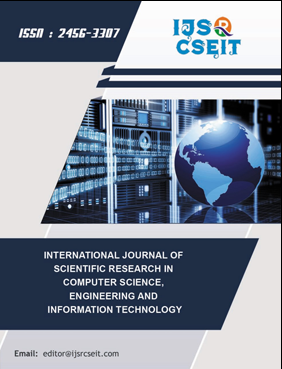An Effective Optimization in Education System using Decision Support Systems
DOI:
https://doi.org/10.32628/CSEIT24103111Keywords:
Mining, Databases, Information, Dataset, Predictions, PerformanceAbstract
For academics, the process of retrieving information from large datasets, known as data mining, has become a captivating area of research. The concept of utilizing data mining techniques to extract information has been in existence for several decades. The dataset was initially designed to be divided into sections and analyzed using classification and clustering methods to explore its intrinsic characteristics. They make their forecasts based on these features. These predictions have been generated in the field of educational data mining for several purposes, such as forecasting student achievement using individual traits and assisting students in identifying suitable professors and courses. These targets have been derived from the analysis of student attrition and retention. Our study is centered around the aims of student attrition and retention. In addition, we have discovered intriguing indicators that contribute to the prediction of students' success, indicating the most competent instructors, and helping them with their choice of courses.
📊 Article Downloads
References
R. Sasi Regha, Dr R. Uma Rani, “Optimization Feature Selection for classifying student in Educational Data Mining”, International Journal of Innovations in Engineering and Technology (IJIET) Volume 7, Volume 7 Issue 4 December 2016 ISSN: 2319 – 1058
Rasha Radi Shalabi, “The Importance and Applications of Decision Support Systems (Dss) in Higher Education”, DOI: 10.6084/m9.figshare.12465599.v1, 2020
Khalid A. Fakeeh, “Decision Support Systems (DSS) in Higher Education System”, International Journal of Applied Information Systems (IJAIS) – ISSN : 2249-0868 Foundation of Computer Science FCS, New York, USA Volume 9 – No.2, June 2015
Abaya, S. A., & Gerardo, B. D. (2013, September). An education data mining tool for marketing based on C4. 5 classification technique. In e- Learning and e-Technologies in Education (ICEEE), 2013 Second International Conference on (pp. 289-293). IEEE. DOI: https://doi.org/10.1109/ICeLeTE.2013.6644390
Aher, S. B., & Lobo, L. M. R. J. (2012). A comparative study of association rule algorithms for course recommender system in e-learning. International Journal of Computer Applications, 39(1), 48-52. DOI: https://doi.org/10.5120/4788-7021
Attrition and retention in higher education institution: A conjoint analysis of consumer behavior in higher education. Asia Pacific Journal of Education, Arts and SCIENCE, 1(5), 107-118.
Baker, R. S., & Inventado, P. S. (2014). Educational data mining and learning analytics. In learning analytics (pp. 61-75). Springer New York. DOI: https://doi.org/10.1007/978-1-4614-3305-7_4
Baradwaj, B. K., & Pal, S. (2012). Mining educational data to analyse students' performance. arXiv preprint arXiv: 1201.3417.
Bydžovská, H. (2013). Course Enrolment Recommender System (Doctoral dissertation, Masarykova univerzita, Fakulta informatiky).
Cabrera, A. F., Nora, A., & Castaneda, M. B. (1993). College persistence: Structural equations modeling test of an integrated model of student retention. The journal of higher education, 64(2), 123-139. DOI: https://doi.org/10.1080/00221546.1993.11778419
Dougiamas, M., & Taylor, P. (2003). Moodle: Using learning communities to create an open source course management system. Drea, C. (2004). Student Attrition and Retention in Ontario's Colleges. College Quarterly, 7(2), n2.
Elbadrawy, A., Polyzou, A., Ren, Z., Sweeney, M., Karypis, G., & Rangwala, H. (2016). Predicting Student Performance Using Personalized Analytics. Computer, 49(4), 61-69. DOI: https://doi.org/10.1109/MC.2016.119
Tamás Gál, “PYTHON LIBRARIES” Astronomy ESFRI & Research Infrastructure Cluster ASTERICS – 653477, 2018.
Guarín, C. E. L., Guzmán, E. L., & González, F. A. (2015). A model to predict low academic performance at a specific enrollment using data mining. IEEE Revista Iberoamericana de Tecnologias del Aprendizaje, 10(3), 119-125. DOI: https://doi.org/10.1109/RITA.2015.2452632
Hung, J. L., & Zhang, K. (2008). Revealing online learning behaviors and activity patterns and making predictions with data mining techniques in online teaching. MERLOT Journal of Online Learning and Teaching.
Inoue, S., Rodgers, P. A., Tennant, A., & Spencer, N. (2017). Reducing Information to Stimulate Design Imagination. In Design Computing and Cognition'16 (pp. 3-21). Springer, Cham. DOI: https://doi.org/10.1007/978-3-319-44989-0_1
Kabakchieva, D. (2013). Predicting student performance by using data mining methods for classification. Cybernetics and Information Technologies, 13(1), 61-72. DOI: https://doi.org/10.2478/cait-2013-0006
Downloads
Published
Issue
Section
License
Copyright (c) 2024 International Journal of Scientific Research in Computer Science, Engineering and Information Technology

This work is licensed under a Creative Commons Attribution 4.0 International License.




